Co-Managed IT Services: The Complete Guide to Hybrid IT Support
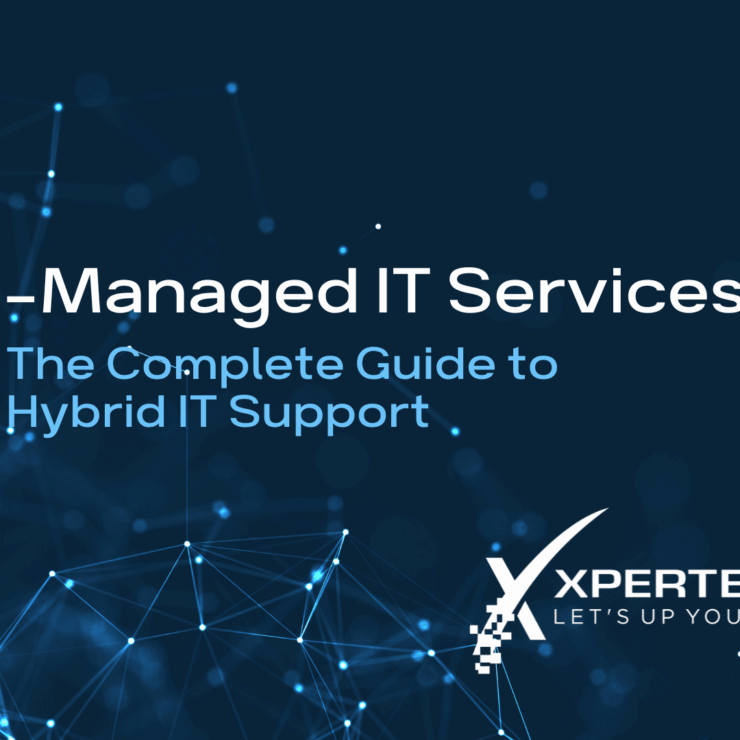
Your IT team is drowning in tasks they can’t ever seem to get to. Tickets pile up faster than they can be resolved. Security threats evolve daily while your team struggles to keep up with basic maintenance. Strategic technology projects get shelved indefinitely because there’s no time to plan, let alone implement.
You know you need help. Maybe you’ve considered fully managed IT services, where an outside company takes over your entire IT function. But totally outsourcing everything doesn’t feel like the right way to go. Your team knows your business. They understand your unique challenges and requirements. What you need isn’t replacement; it’s a way to supplement your internal IT team so they can focus on their strengths while you gain the expertise you’re missing.
That’s exactly what co-managed IT services provide.
In this guide we’ve put together information you can use to decide if co-managed IT services make sense for your organization.
Table of Contents
Recognizing When Your IT Team Needs Support
Most IT teams don’t suddenly become overwhelmed overnight. The pressure builds gradually until small problems become major disruptions. You might notice:
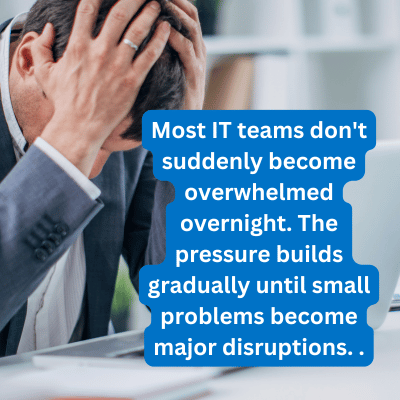
1. Response Times Keep Getting Slower
Issues that should take minutes to resolve stretch into hours or days. Your team isn’t incompetent; they’re just handling too many things at once. When everything is urgent, nothing gets the attention it deserves.
2. Security Keeps You Awake at Night
Cybersecurity threats change daily. New vulnerabilities emerge constantly Your team knows security is critical to protecting your business and data, but between user support and system maintenance, staying current with threat intelligence becomes impossible.
3. Strategic Projects Never Happen
You have a list of technology improvements that would genuinely help the business, like cloud migration, automation projects, and AI implementation. But these initiatives keep getting pushed back because your team can’t get ahead of daily operations.
4. Your IT Staff Works Too Many Hours
Overtime becomes standard. Vacation requests get denied because there’s no coverage. Your best people start looking burned out, and you worry about losing them.
5. You’re Missing Opportunities
Your team knows security is critical to protecting your business and data, but between user support and system maintenance, staying current with threat intelligence becomes impossible.
These aren’t signs of IT failure. They’re signs that good people are stretched beyond reasonable limits and need reinforcement. That’s exactly what co-managed IT services provide.
What Are Co-Managed IT Services
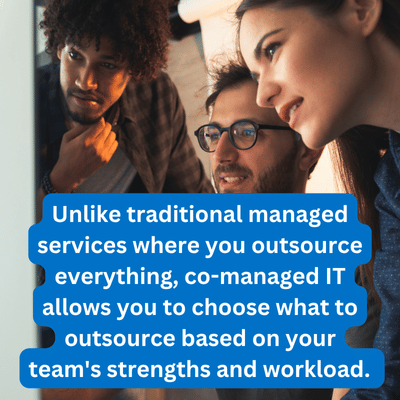
Co-managed IT services create a partnership between your internal IT staff and an external managed service provider (MSP). You keep your team and their knowledge about your business operations and workflows. The MSP fills the gaps with specialized expertise, additional capacity, advanced tools, and 24/7 coverage.
Unlike traditional managed services where you outsource everything, this partial IT outsourcing approach lets you choose what to outsource based on your team’s strengths and workload. Maybe your team excels at application management but struggles with cybersecurity. Or they handle user support well but don’t have time for infrastructure planning. The MSP becomes an extension of your IT department, handling the areas where you need help.
How to Split Responsibilities with Co-Managed IT
The biggest question about co-managed IT is usually: who does what? The answer depends entirely on your situation, but here are common ways organizations divide the work. Keep in mind that arrangements can evolve as your needs change. You might start by outsourcing cybersecurity management, then add infrastructure management as your business grows.
What Your Internal Team Might Handle:
- Daily user support and help desk tickets
- Application management for your industry-specific software
- Physical hardware tasks and on-site troubleshooting
- Communication between IT and other departments
- Business-specific IT knowledge and requirements
What Co-Managed Providers Might Handle:
- Advanced cybersecurity monitoring and incident response
- Infrastructure management and proactive maintenance
- Complex technical issues requiring specialized knowledge
- After-hours monitoring and emergency support
- Implementation of new systems and technologies
- Strategic planning and budget recommendations
Integrating Your In-House and Co-Managed Team
Success requires both teams to work as one department. This means shared tools, common documentation, and clear communication protocols.
Most organizations use ticketing systems where both teams can see ongoing work. This prevents duplicate effort and ensures nothing gets missed. Additionally, documentation platforms keep everyone working from the same network diagrams and procedures.
The key is transparency. Both teams need visibility into what the other is doing.
Finding Your Co-Managed IT Partner
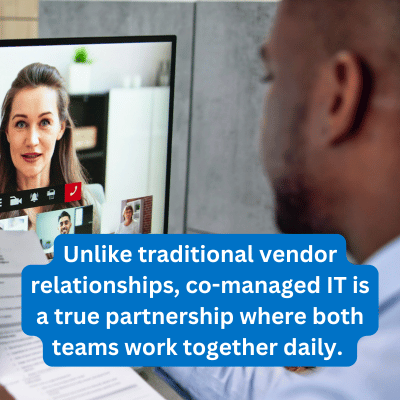
Finding the right co-managed IT partner is crucial to your success. Unlike traditional vendor relationships, this is a true partnership where both teams work together daily. The wrong provider can create friction, duplicate efforts, or fail to deliver the expertise you need.
You’ll need to look beyond technical capabilities to assess the MSP’s collaboration skills and partnership approach. Ask about their experience with co-managed arrangements, consider requesting references from similar organizations, and understand their escalation procedures. Here are key qualities to discuss in your conversations:
Collaboration Experience: They’ve successfully worked alongside internal IT teams before. They understand the dynamics and have processes for sharing responsibilities without stepping on toes.
Complementary Skills: They bring expertise that enhances your team’s capabilities rather than duplicating them. For example, if your strength is application management, they excel at infrastructure. If you handle user support well, they provide enterprise-level security.
Transparent Communication: They document everything, provide regular reports, and keep all stakeholders informed. You never wonder what they’re working on or why.
Cultural Alignment: Their team integrates well with your organization’s communication style and work approach. When teams clash on basic communication preferences or work styles, daily collaboration becomes frustrating and inefficient.
Knowledge Sharing: They’re willing to share knowledge and collaborate openly rather than hoarding information to maintain dependency.
Get detailed guidance on this evaluation process: How to Evaluate Co-Managed IT Service Providers
Managing the Transition to Co-Managed IT
Once you’ve chosen a co-managed provider, the transition process sets the stage for everything that follows. A well-managed transition prevents disruption while building the foundation for effective collaboration.

Setting Clear Expectations
The transition begins with defining roles, responsibilities, and communication protocols. Both your internal team and the provider need to understand exactly who handles what, when escalations occur, and how information is shared.
Document your expectations for response time, reporting requirements, and decision-making authority. Clear boundaries prevent confusion and ensure smooth operations from the start.
Onboarding and Integration
The onboarding process typically takes 4-8 weeks depending on the complexity of your environment and the scope of services. During this time, the MSP needs to understand your infrastructure, document your systems, and deploy monitoring tools. Your internal team needs time to adjust to new workflows and communication channels.
Maintain frequent communication during this period. Regular check-ins help address concerns quickly and build working relationships between the teams.
Building Long-Term Success
Co-managed IT isn’t a “set it and forget it” arrangement. The most successful partnerships involve ongoing communication, regular reviews, and adjustments as business needs evolve.
These partnership reviews are essential for long-term success. They keep both teams aligned, address issues quickly, and continuously improve collaboration as your business grows.
Learn what to expect during your transition: Transitioning to Co-Managed IT Services
Understanding Co-Managed IT Costs
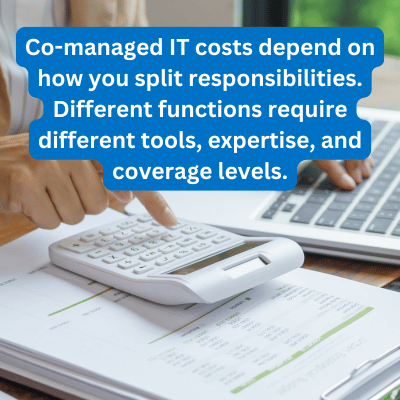
Co-managed IT costs depend on how you split responsibilities. Different functions require different tools, expertise, and coverage levels.
Your specific needs also vary based on industry compliance requirements, operational hours, infrastructure complexity, and business priorities. A law firm needs different security measures than a manufacturing company. A 24/7 operation requires different coverage than a traditional office environment.
With all these variables, standard pricing isn’t possible. Most providers need to understand your current setup, what’s working, what isn’t, and what you’re trying to accomplish before they can provide accurate pricing.
Cost Drivers for Co-Managed IT Services
Scope of Responsibilities: The number and type of functions you outsource directly impacts cost. Infrastructure management, cybersecurity monitoring, and help desk support each have different pricing.
Coverage Requirements: 24/7 monitoring and support costs more than business-hours coverage due to staffing and resource requirements.
Environment Complexity: Complex, multi-vendor infrastructures require more time and expertise to manage than simpler environments.
Industry Requirements: Regulated industries need specialized compliance expertise and tools that add to the investment.
Get more details about pricing factors: What Does Co-Managed IT Cost?
The Impact of Co-Managed IT
When implemented correctly, co-managed IT services solve the problems that overwhelm internal teams while preserving the benefits of in-house expertise.
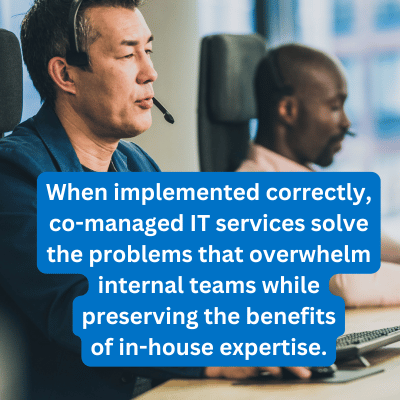
Relief for IT Managers
Co-managed services supplement your internal IT team with additional expertise and capacity. This gives your team more bandwidth to focus on strategic initiatives instead of constantly reacting to urgent issues and system problems.
Your systems become more stable through enhanced monitoring and proactive maintenance. Projects get completed faster with additional expertise and resources. You’re also better positioned to adopt new technologies like AI and automation that require specialized knowledge and implementation expertise.
Plus, your people can work more reasonable hours and take time off without worrying that everything will break while they’re gone.
IT That Drives Business Growth
Co-managed IT gives your team additional capacity and expertise. This means better system reliability, faster issue resolution, and the ability to finally tackle projects that have been sitting on the back burner.
Your IT function moves from constantly reacting to problems to proactively supporting your organization’s goals. You also gain access to specialized knowledge for implementing new technologies like AI and automation that can give your business a competitive advantage.
XPERTECHS Co-Managed IT Client Success Story
Friedman, Framme and Thrush P.A. wanted to stay ahead of technology trends, not follow them. But with limited internal IT resources, innovation felt impossible.
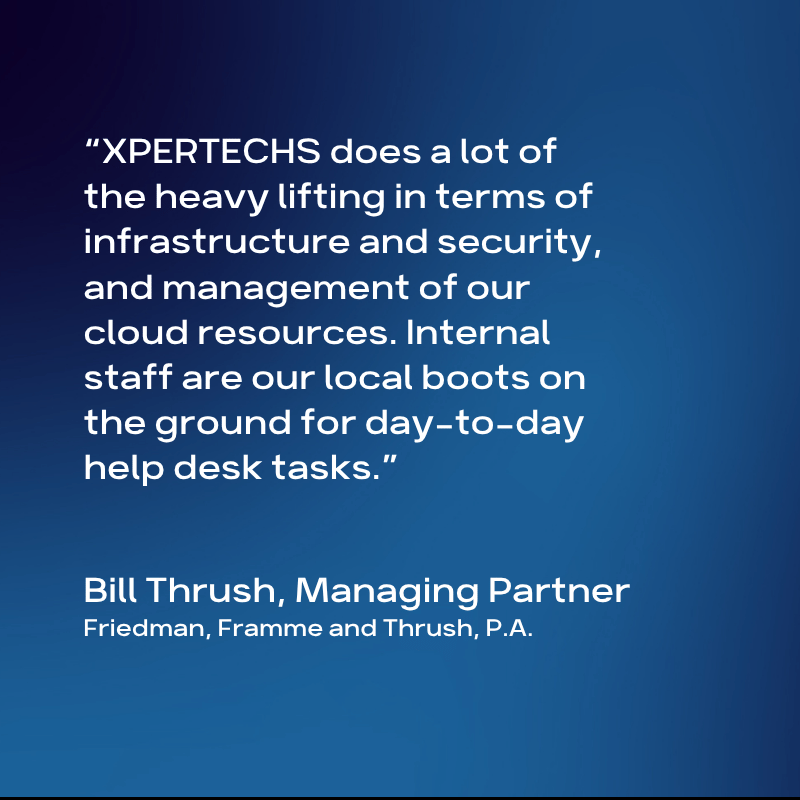
The Challenge
Managing Partner Bill Thrush described himself as “a tinkerer” always looking for ways to improve efficiency. When their network administrator passed away, the firm faced a choice: hire a replacement or try a different approach.
The legal industry’s slow technology adoption meant few firms were pushing boundaries. Thrush wanted his firm to be different, but he needed help to make it happen.
The Co-Managed Solution
Instead of hiring another full-time administrator, the firm partnered with XPERTECHS. XPERTECHS took over network and cybersecurity management while internal staff continued handling daily user support.
This gave the firm access to enterprise-level expertise while maintaining personal support for their employees.
The Results
The co-managed approach enabled initiatives that would have been impossible with internal resources alone. The firm successfully downsized physical office space while expanding virtual capabilities, creating a remote work system that proved invaluable during COVID-19.
Today, they continue exploring emerging technologies like artificial intelligence and automation.
“I want to be at pace or ahead of the pace of the market in terms of technology,” Thrush explained. “To maintain that, you need somebody like XPERTECHS in your corner because you can’t rely on the knowledge of one or two IT people to keep you up to date.”
Read the complete success story: Legal Firm Co-Managed IT Success Story
Is Co-Managed IT Right for Your Organization?
Co-managed IT is designed for organizations that have internal IT capabilities but need additional expertise, capacity, or coverage. If you recognize the challenges we described earlier – overwhelmed IT teams, missed opportunities, or the need for specialized expertise – co-managed IT can help.
At XPERTECHS, we understand that every business has unique needs and challenges. Our co-managed IT approach complements your existing team’s strengths while providing the additional expertise and resources you need to achieve your technology goals.
Contact us today to schedule a conversation about your specific situation and discover how co-managed IT services can enhance your team’s capabilities and position your business for continued success.
